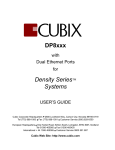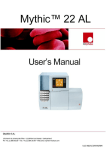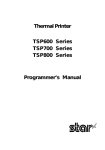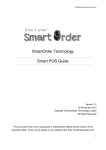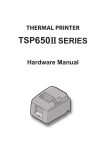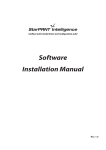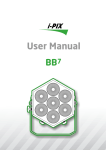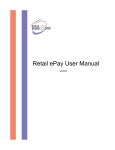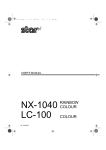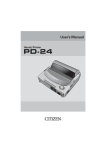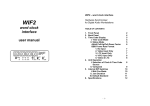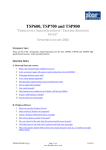Download DP8340RC Serial Interface User`s Manual
Transcript
DOT MATRIX PRINTER DP8340RC SERIES [PARALLEL INTERFACE] USERS MANUAL Federal Communications Commission Radio Frequency Interference Statement This equipment has been tested and found to comply with the limits for a Class A digital device, pursuant to Part 15 of the FCC Rules. These limits are designed to provide reasonable protection against harmful interference when the equipment is operated in a commercial environment. This equipment generates, uses and can radiate radio frequency energy and, if not installed and used in accordance with the instruction manual, may cause harmful interference to radio communications. Operation of this equipment in a residential area is likely to cause harmful interference in which case the user will be required to corect the interference at his own expense. For compliance with the Federal Noise Interference Standard, this equipment requires a shielded cable. This statement will be applied only for the printers marketed in U.S.A. Statement of The Canadian Department of Communications Radio Interference Regulations This digital apparatus does not exceed the Class A limits for radio noise emissions from digital apparatus set out in the Radio Interference Regulations of the Canadian Department of Communications. Le présent appareil numérique n’émet pas de bruits radioélectiques dépassant les limites applicables aux appareils numériques de la classe A prescrites dans le Règlement sur le brouillage radioélectrique édicté par le ministère des Communications du Canada. The above statement applies only to printers marketed in Canada. Trademark acknowledgments DP8340RC: Star Micronics Co. Ltd. Notice • • • • All rights reserved. Reproduction of any part of this manual in any form whatsoever, without STAR’s express permission, is strictly forbidden. The contents of this manual are subject to change without notice. All efforts have been made to ensure the accuracy of the contents of this manual at the time of printing. However, should any errors be found, STAR would greatly appreciate being informed of them. The above notwithstanding, STAR can assume no responsibility for any errors in this manual. © Copyright 1986, 1999 Star Micronics Co., Ltd. TABLE OF CONTENTS 1. OUTLINE .............................................................................................. 1 2. UNPACKING AND INSTALLATION ................................................ 2 2-1. Unpacking .................................................................................... 2 2-2. Installation of Paper Holders and Re-Roll Prevention Guard ......................................................................... 3 2-3. Handling Notes............................................................................. 4 3. PART IDENTIFICATION AND NOMENCLATURE ........................ 5 3-1. Power Supply Unit ....................................................................... 5 3-2. Printer ........................................................................................... 6 3-3. Part Functional Description.......................................................... 7 4. INSTALLATION OF INK RIBBON AND PAPER ............................. 8 4-1. Installation of Ink Ribbon ............................................................ 8 4-2. Removal of Ink Ribbon ................................................................ 9 4-3. Paper Insertion ........................................................................... 10 4-3-1. For Roll Paper ................................................................. 10 4-3-2. Roll Paper Installation (When using the optional Printer Cover 8340R) ............. 11 4-3-3. Validation Option Installation ......................................... 12 4-4. Roll Paper Removal ................................................................... 12 5. CONTROL CODES ............................................................................ 13 6. GENERAL SPECIFICATIONS .......................................................... 20 7. INTERFACE ....................................................................................... 24 7-1. Interface Specifications .............................................................. 24 7-2. Interface Timing ......................................................................... 24 7-3. Connectors and Signals .............................................................. 25 7-4. Setting of DIP Switches ............................................................. 26 7-5. Peripheral Unit Drive Circuit ..................................................... 27 7-6. Error Condition Alarm Mode ..................................................... 27 8. WHEN POWER IS SUPPLIED BY THE USER ............................... 28 9. CHARACTER CODE LIST ................................................................ 30 1. OUTLINE The DP8340RC series of serial dot matrix printers is for use in ECR, POS, electronic instruments, banking machines and computer peripheral equipment. The DP8340RC series include the following features; 1) 2 color printing (Red and Black) 2) High-speed bidirectional printing (2 line/sec, 29 or 44 columns per line) 3) 9-pin print head 4) Parallel interface (Centronics compatible) 5) Commands for expanded characters, inverted characters, emphasized characters, red and black printing, and 10CPI or 15CPI characters etc. are provided, which makes the printer very versatile. 6) Simultaneous Data Communication and Printing 7) 2 Peripheral Drivers 8) One line validation printing (Option) Model Name Notation –1– 2. UNPACKING AND INSTALLATION 2-1. Unpacking After opening the box, check if all necessary accessories are included. (A) Printer 1 Printer 2 User’s Manual 3 Paper Holders 4 Re-Roll Prevention Guard 5 Ink Ribbon 6 DIP Switch Cover (B) Power Supply Unit 1 1 Power Supply Unit 2 User’s Manual Figure 2-1. Unpacking –2– 2-2. Installation of Paper Holders and Re-Roll Prevention Guard Install the Paper Holders in the intermost holes in the rear of the printer. Figure 2-2. Installation of Paper Holders –3– Install the Re-Roll Prevention Wire in the holes of the printer cover. Twisting the Wire as shown in the figure below, will make the installation easier. Figure 2-3. Installation of Re-Roll Prevention 2-3. Handling Notes (1) (2) (3) Install the printer near an easily accessible socket-outlet. Place the unit on a flat and stable surface for operation. Do not connect the AC Power Plug to the same outlet used for other noise generating devices (large motors, etc.). (4) Be careful not to drop paper clips, pins and other foreign objects into the unit. (5) Wipe off dirt with a soft cloth soaked in alcohol or benzine. Do not use Lacquer thinner, Trichlorethelene or Ketone solvents because they may damage plastic parts. (6) Use a soft brush, etc. for cleaning the printer mechanism and PCB. (7) Keep hands out of printer while power is on. (8) Do not attempt to print when there is no ink ribbon or paper in the unit. The print head life could be severly reduced. (9) If the paper is fastened tightly to the roll, the paper may not detach from the roll when the end is reached. If this happens, the no paper detection function and paper feed will not operate. (10) Always keep the printer cover attached when printing to prevent paper jams, noise, and other problems. (11) Always turn the power off before opening the printer cover. (e.g. When renewing a ink ribbon) –4– 3. PART IDENTIFICATION AND NOMENCLATURE 3-1. Power Supply Unit DC Power Connector (Output) Shape of AC Power plug will vary according to destinations. Figure 3-1. Power Supply Unit –5– 3-2. Printer Figure 3-2. Printer: Front View Figure 3-3. Printer: Rear View –6– 3-3. Part Functional Description (1) (2) (3) (4) (5) AC Power Plug DC Power Outlet Printer Cover POWER Lamp ON LINE Lamp Connect to an outlet of the specified voltage. Supplies DC 12V power to the printer. Protects the printer against dust and reduces noise. Lights up (green LED) when power is on. Lights up (green LED) when the unit is in the online mode. (6) ALARM Lamp Lights up (red LED) when printer operation is not normal, or the printer is out of paper. It is necessary to install paper into the printer and press the ON LINE Button to recover from paper empty status. Turn off the printer power in order to recover from abnormal operation. (7) ON LINE Button Toggles between the on-line and off-line modes. The printer will go on-line after turning power on. (8) FEED Button Momentary operation of this button provides one line feed. Pressing this button continuously will cause continuous paper feed. If power is turned on while pressing this button, self printing*1 will be performed. (9) Interface Connector Connects the printer to host computers. Check that both computer and printer are off before connecting. (10) DIP Switches Allows for setting of various functions according to user requirements. (11) Peripheral Drive Connects the printer to the peripheral devices such Output as Cash Drawer, Paper Cutter and Paper Take-Up Device etc. to drive them. *1 Self Printing This printer has another convenient function, the Automatic Test Printing. With the ink ribbon and paper properly installed in the printer, turn the power ON while holding down the Feed switch. Test printing will start and stop again automatically. –7– 4. INSTALLATION OF INK RIBBON AND PAPER 4-1. Installation of Ink Ribbon (1) Turn power off, lift the Printer Cover up and remove it. Note: Be careful not to touch the print head immediately after printing, because it can get very hot. Figure 4-1. Printer Cover Removal (2) (3) (4) Unwind ribbon so that the spools are separated as shown in Figure 4-3. Hold the ribbon taut as shown with the drive pins facing down and slide the ribbon between the print head and the platen. While keeping the ribbon taut, wrap one side around the black ribbon guide on the end of the platen and drop one spool on the spool shaft. As you move the spool downwards, move the detecting lever aside to allow the spool to drop into place. Make sure the spool drive pins engage with the spool drive holes. As the spool drops into place there will be a click. While continuing to hold the ribbon taut, install the remaining ribbon spool in a similar fashion. Turn the spool that rotates freely to take up the ribbon slack. Ribbon Life Description SF-03BR (Fuji Kagakushi Kogyo Co., Ltd.) Ribbon life Black Red Approx. 0.8 million characters –8– Approx. 0.4 million characters Ribbon Life Ribbon life Description Black SF-03B (Fuji Kagakushi Kogyo Co., Ltd.) Approx. 0.8 million characters Figure 4-2. Installation of Ink Ribbon Figure 4-3. Ribbon Spools 4-2. Removal of Ink Ribbon Hold the spool and lift gently, rotating it until the ribbon sags. Push the ribbon detecting lever out, lift the spool until it comes off the shaft. Remove the second spool in a similar manner. (Do not apply excessive force when lifting spools.) –9– 4-3. Paper Insertion 4-3-1. For Roll Paper (1) (2) (3) (4) Cut the Roll Paper end straight and square. Hold the roll so that the paper comes from the bottom. Attach the Roll Paper to the Holders Paper by slipping one side of the roll onto the Hub and pulling the other Hub out to allow the roll to slip in place. Insert the paper evenly into the Paper Insertion Slot. Turn the Power Switch “ON”, and press the FEED Button. The paper will be fed into the unit. Figure 4-4. Paper Insertion (1) Figure 4-5. Paper Insertion (2) – 10 – 4-3-2. Roll Paper Installation (When using the optional Printer Cover 8340R) When installing roll paper with the optional “Ptinter Cover 8340R”, please use the following procedure. (1) Turn power off, lift the Printer Cover up and remove it. Note: Be careful not to touch the print head immediately after printing because it can get very hot. (2) Insert paper into the printer, and feed the paper so it extends 3 inches or more above the top surface of the printer. (3) Insert the paper into the slot in the “Printer Cover 8340R”. (4) Install the “Printer Cover 8340R” on the printer. Figure 4-6. Replace the Printer Cover Figure 4-7. Printer Cover 8340R – 11 – 4-3-3. Validation Option Installation The validation printing requires the optional printer cover 8340R. Refer to item 4-3-2 for the installation. (1) Turn power ON. (2) Enter the printer the validation mode. (Refer to the control code “GS” in Chapter 5.) (3) Insert the material to be validated against the right side of the slot in the Printer Cover 8340R. Figure 4-8. Insertion of Material to be validated 4-4. Roll Paper Removal Cut the paper close to the slot and use the feed button until paper has passed completely through the printer. Note: Do not try to remove the paper by hand as it could become crooked and get jammed inside the printer. – 12 – 5. CONTROL CODES CODE FUNCTION LF (0A)H Print and line feed instruction OUTLINE The LF code causes the data in the line buffer to be printed, followed by a single line feed. When the line buffer is empty, only the feed takes place. CODE CR (0D)H Print and line feed instruction FUNCTION OUTLINE Same function as of LF code. However, when the DIP switch 3 is ON, the CR code becomes invalid. CODE SO (0E)H Expanded character instruction FUNCTION OUTLINE This code causes the printer to print expanded characters twice as wide as the regular ones. This remains in effect until a DC4 code is received. CODE DC4 (14)H Release from expanded characters FUNCTION OUTLINE The expanded character instruction is released by the DC4 code, and the succeeding data is printed as regular width characters. CODE ESC-1 (1B)H (2D)H (01)H or (1B)H (2D)H (31)H Underline mode selection FUNCTION OUTLINE All data received after this code is underlined until a ESC-0 is received. CODE FUNCTION ESC-0 (1B)H (2D)H (00)H or (1B)H (2D)H (30)H Release from underline mode OUTLINE The underline mode selection is released by this code. – 13 – CODE FUNCTION SI (0F)H Inverted print instruction OUTLINE This function causes the printing to be inverted. This code must be received at the beginning of a line. If this code is received anywhere other than at the beginning of a line, it is disregarded. Accordingly, normal characters and inverted characters, can not be mixed on the same line. CODE DC2 (12)H Release from inverted print instruction FUNCTION OUTLINE The inverted print instruction is released by this code. This code must be received at the beginning of a line. CODE ESC E (1B)H (45)H Emphasized print mode instruction FUNCTION OUTLINE Data following this command is printed with emphasized characters. In this mode, characters are printed in a single direction. CODE FUNCTION ESC F (1B)H (46)H Release from emphasized print instruction OUTLINE Emphasized print is released. CODE ESC 4 (1B)H (34)H Red character print instruction FUNCTION OUTLINE This command causes subsequent data to be printed with red characters. The instruction is released by the code, ESC 5. Red and black characters may be intermixed. This command is ignored when DIP SW 5 is OFF. CODE FUNCTION ESC 5 (1B)H (35)H Release from red character print instruction OUTLINE The red character print instruction is released by this code. – 14 – CODE FUNCTION ESC a n (1B)H (61)H n n-line feed OUTLINE After printing the data in the current line, n lines are fed by this code. The value of n ranges from 1 to 120. CODE ESC C n (1B)H (43)H n Sets page length in lines FUNCTION OUTLINE This code sets the length of a page to n lines. The value of n ranges from 1 to 120. On initialization, the page length default condition will be 42 lines. The line feed pitch is onesixth inch. CODE ESC Nn (1B)H (4E)H n Sets bottom margin in lines FUNCTION OUTLINE Upon receiving this code, the bottom margin is set to n lines. 0 n 120; Default Value n = 0 CODE FUNCTION ESC O (1B)H (4F)H Cancels bottom margin. OUTLINE Upon input of this code, bottom margin setting is cleared. CODE FF (0C)H Form feed FUNCTION OUTLINE The FF code prints the data in the current line and transports the paper to the start of the next page. – 15 – CODE FUNCTION ESC @ (1B)H (40)H Printer initialization OUTLINE All printing conditions except ESC BEL n1 n2, the line buffer and data buffer are set to the power on default condition. CODE ESC BEL n1 n2 (1B)H (07)H n1 n2 Sets peripheral unit drive 1 pulse duration. FUNCTION OUTLINE This command sets the pulse duration for peripheral unit drive (Paper Cutter, Take-Up Device, cash drawer, etc.) Pulse Duration = 10 × n1 (ms) Delay = 10 × n2 (ms) 1 n1 127; 1 n2 127 Default value: n1 = n2 = 20 Executed by BEL code and FS code after printing. CODE FUNCTION OUTLINE BEL (07)H Trigger peripheral unit drive 1 (Deferred) Causes a peripheral drive 1 pulse to be generated. This code is normally stored in the buffer and is performed as it is received from the data queue. – 16 – FUNCTION FS (1C)H Trigger peripheral unit drive 1 (immediate) OUTLINE Causes a peripheral drive 1 pulse to be generated immediately CODE SUB (1A)H Trigger peripheral unit drive 2 (immediate) CODE FUNCTION OUTLINE REMARKS CODE FUNCTION This command causes a peripheral unit drive 2 pulse to be generated. Pulse Duration : 200ms (fixed) Delay : 200ms (fixed) It is impossible to drive peripheral devices 1 and 2 at the same time. CAN (18)H Clears print buffer OUTLINE Upon input of this code the data buffer and line buffer are cleared. CODE ESC P (1B)H (50)H Select 10 CPI FUNCTION OUTLINE This code causes the printer to print at 10 CPI. The number of columns per is 29. CODE ESC M (1B)H (4D)H Select 15 CPI FUNCTION OUTLINE This code causes the printer to print at 15 CPI. The number of columns per line is 44. When the power is turned on, the 15 CPI mode is selected. – 17 – CODE FUNCTION OUTLINE REMARKS GS (1D)H Validation printing instruction This code causes the printer to perform validation printing of a maximum of 32 subsequent characters (at 15 CPI, from the thirteenth to the forty-forth column). After the GS code is received, a maximum of 32 characters should be input, followed by the LF code which indicates the end of the validation printing data. (At this time, control codes except FS, ENQ, CAN and SUB codes, or any character received beyond the limit of 32 characters are ignored.) When the printer enters the validation mode, the ribbon is shifted up and the ON-LINE lamp blinks. (This lamp goes on and off at a 0.5-second interval until the end of the validation mode.) After the material to be validated is inserted, and the LF button is pressed, the validate line is printed, followed by a single line feed. When the check is removed and the ON-LINE button is pressed, the printer returns to regular mode and is set to ON-LINE status. 1) The print settings by commands (such as emphasized mode and underline mode) are invalid only during validation printing. 2) When the CAN code is received in the validation mode, the printer returns to regular mode, and the mechanism is initialized. 3) If the FS or SUB codes is received in the validation mode, these codes are executed just after the printer returns to regular mode. 4) In the validation mode, the LF button and the ON-LINE button do not work except the above behavior. 5) If the printer has a Red black ribbon installed, the validate line will be printed in red. – 18 – Character Code List Character Code 1 LF 2 CR (0A)H (0D)H 3 SO 4 DC4 5 ESC-1 7 SI 8 DC2 9 ESC E (0E)H (14)H (1B)H (2D)H(01)H (1B)H (2D)H (31)H (1B)H (2D)H(00)H (1B)H (2D)H (30)H (0F)H (12)H (1B)H (45)H 10 11 12 13 14 ESC F ESC 4 ESC 5 ESC a n ESC C n (1B)H (46)H (1B)H (34)H (1B)H (35)H (1B)H (61)H n (1B)H (43)H n 15 ESC N n (1B)H (4E)H n 16 17 18 19 (1B)H (4F)H (0C)H (1B)H (40)H (1B)H (07)H n1 n2 6 ESC-0 ESC O FF ESC @ ESC BEL n1 n2 20 BEL 21 FS (07)H (1C)H 22 SUB (1A)H 23 24 25 26 (18)H (1B)H (50)H (1B)H (4D)H (1D)H CAN ESC P ESC M GS Function Print and line feed instruction Print and line feed instruction (same as LF) Expanded character instruction Expanded character release Underline instruction Underline release Inverted print instruction Inverted print release Emphasized print instruction (one-way printing) Emphasized print release Red character print instruction Red character print release n-line feed instruction Sets page length in lines 1 n 120 (default n = 42) Set bottom margin in lines 0 n 120 (default n = 0) Cancel Bottom margin Form feed Printer initialization instruction Set peripheral unit drive 1 pulse duration 1 n1 127, 1 n2 127 (default n1 = n2 = 20) Trigger peripheral unit drive 1 (Deferred) Trigger peripheral unit drive 1 (Immediate) Trigger peripheral unit drive 2 (Immediate) Clears print buffer Select 10 CPI Select 15 CPI (Default value) Validation printing instruction – 19 – 6. GENERAL SPECIFICATIONS Printing method Serial impact dot matrix printing, 9 wires Number of print columns 29 columns (10CPI), 44 columns (15CPI) Print speed Approx. 2 lines/sec Print direction Bi-directional Line spacing 1/6 inch Paper feed method Friction Feed Paper feed speed Approx. 12 lines/sec Character set ASCII 96 characters Special 64 characters Block graphics* 64 characters Katakana (Japanese) 64 characters Font configuration 10CPI Ordinary characters 5 × 9 dots Block graphics* 6 × 6 dots 15CPI Ordinary characters 7 × 9 half dots Block graphics* 5 × 6 dots * Graphic Feed Not Available Character size 10CPI 2.00 (H) × 2.42 (V) mm 15CPI 1.32 (H) × 2.42 (V) mm Character spacing 10CPI 2.55 mm (1/10 inch) 15CPI 1.70 mm (1/15 inch) Dot spacing 10CPI H=0.425 mm V=0.353 mm 15CPI H=0.340 mm V=0.353 mm Gross dot 10CPI 174 dots/wire/line 15CPI 220 dots/wire/line Print area 10CPI 73.53 mm 15CPI 74.46 mm Print Buffer Approx. 1.5 KB Interface Parallel Interface (Centronics compatible) Peripheral drive 2 outputs (each 1A max. at 12V. Both cannot operate at the same time.) External dimensions (Printer) 202(W) × 200(D) × 98(H) mm (without paper holder, DC Power Connector) (Power supply unit) 60(W) × 120(D) × 36(H) mm (without AC cable) Weight (Printer) Approx. 1.9 kg (Power supply unit) Approx. 0.4 kg (without AC cable) – 20 – Power supply unit Four supplies available with following ratings Input Output AC 100 – 240 V 47Hz – 63 Hz 0.8 A Max DC 12.0 V ± 5% Paper specification Paper type Size Paper width Roll diameter Thickness (single) (2 copy) Paper end One line validation Ink ribbon specification Color Ribbon material Ribbon size Spool Recommended ribbon Operating conditions Storage conditions Head life Printer reliability 2.0 A Ordinary and carbonless copy paper 82.55 ± 0.5mm (3.25 inches) 80 mm outer diameter (Max) 0.07 mm (52.3 g/m2) to 0.09 mm (64g/m2) One copy and one original (max 0.13 mm) Paper should not be attached to the core Check (Refer to Fig. 6-2) Paper width 70 to 90 mm Thickness 0.1 to 0.15 mm * Requires the optional Printer Cover 8340R Black and red / Black only Nylon (#40 denier) 13mm × 6m 13mm (width), 35mm in diameter (two spool) SF-03BR (Black and red), SF-03B (Black) (manufactured by Fuji Kagakushi Kogyo Co., Ltd.) or approved equivalent. Temperature +5˚C — +40˚C Humidity 10% — 80%RH Temperature –20˚C — +70˚C Humidity 5% — 95%RH (+40˚C) 70 million characters 5.0 million lines MCBF (except head life) – 21 – Figure 6-1. Roll Paper and Print Area Figure 6-2. Material to be validated and One Line Validation Printing – 22 – 60mm Figure 6-3. External Dimensions (Printer) 36mm 120mm 2.0m Shape of AC Power plug will vary according to destinations. Figure 6-4. External Dimensions (Power Supply Unit) – 23 – 7. INTERFACE 7-1. Interface Specifications This printer has a parallel interface to communicate with the computer. The operating specifications of the parallel interface are as follows. (1) Data transfer rate 1000 to 6000 characters per second (2) Synchronization Via externally supplied STROBE pulses (3) Handshaking ACK and BUZY signals (4) Logic level Compatible with TTL level 7-2. Interface Timing Figure 7-1. Interface Timing Diagram Signal Name Circuit Example DATA1-DATA8 (To Printer) STROBE (To Printer) BUZY, ACK (From Printer) Figure 7-2. Typical Interface Circuit – 24 – 7-3. Connectors and Signals Pin No.Signal Name IN/OUT 1 STROBE IN 2-9 DATA1-8 IN 10 ACK OUT 11 BUSY OUT PAPER OUT 13 SELECTED 14-15 N/C SIGNAL 16 GND CHASSIS 17 GND 18 N/C 19-30 GND 12 OUT OUT Signals when data is ready to be read.Signal gose from HIGH to LOW (for at least 0.5 microsec.) when data is available. These signals provide the information of the first to eighth bits of parallel data.Each signal is at HIGH level for a logical 1 and at a LOW level for a logical 0. A 9 microsecond LOW pulse acknowledges receipt of data. When this signal goes LOW, the printer is ready to accept data. When the printer is in one of the conditions below.”HIGH” is set. 1. Data being entered. 2. Off line. 3. Error condition. This signal is normally LOW. It will go HIGH if the printer runs out of paper. This signal is HIGH when the printer is online. Unused Signal ground. Chassis ground, isolated from logic ground. 31 RESET IN 32 ERROR OUT 33 EXT GND 34-36 N/C Function Unused Twisted pair return signal ground level. When this signal gose LOW, the printer is reset to its power-on condition. This signal is normally HIGH. This signal goes LOW to signal that the printer cannot print due to an error condition. Refer to Item 7-6 Emergency Suspension. External ground. Unused. Figure 7-3. Parallel Interface Connector (Printer side) – 25 – 7-4. Switch 1 2 3 4 5 (*1) 6 7 8 Setting of the DIP Switches Factory settings : all ON ON OFF U.S.A. & Europe Japan Function Character Table Unused CR cord Unused Ink Ribbon Disable Enable 2-color Monochrome International Character Set (See below) (*1) DIP Swich 5 should be set to ON when you use a 2-color ribbon for 2-color printing. It should be set to OFF when a monochrome ribbon is used. International Character Set SW NO. 6 7 8 USA ON ON ON France Germany England Denmark Sweden OFF ON OFF ON OFF ON OFF OFF ON ON ON ON ON OFF OFF Itary ON OFF OFF Spain OFF OFF OFF Note: When DIP Switches 1 is set to OFF, the printer always selects the Japan international character set regardless of the status of DIP Switches 6, 7 and 8. When DIP Swiches 1 is otherwise set, the printer selects the character set determined by DIP Switches 6, 7 and 8. Figure 7-4. DIP Switch Setting – 26 – 7-5. Peripheral Unit Drive Circuit The Control Board of this printer is equipped with a circuit for driving peripheral units (Paper Cutter, Take-Up Device, Cash Drawer, etc.) The 6P Modular Jack is used as the Drive Circuit. When using this circuit, connect the peripheral unit cable to the 6P Modular Jack (cable is not included). Note: Peripheral unit drive circuit connector only connects to peripheral units such as cash drawers, etc.Do not connect it to a telephone. 1. Drive Circuit Drive Output D1 D2 12V,MAX. 1A Absolute Ratings (Ta = 25˚C) Voltage Breakdown 100V Peak Forward Current 1A Note: It is impossible to drive peripheral devices 1 and 2 at the same time [Printer side] Figure 7-5. Drive Circuit Figure 7-6. 6P Modular Jack Connector Figure 7-7. Recommend Cable Note: Make sure that the metal structural parts of the peripheral device are connected to frame Ground (Pin 1) to provide a static drain path. 2. Control code Codes for Drive Circuit control are ESC BEL n1 n2, BEL, FS and SUB. Refer to the Control Codes in Section 5. 7-6. Error Condition Alarm Mode If an error condition is detected during operation, the printer will stop printing and cause the ERROR signal to go Low. All solenoids & motors will be deenergized. It is necessary to turn the printer power off and on again in order to recover from the alarm mode. The printer can detect the following error conditions: a. Motor Lock b. Defective timing detector c. Micro-processor out of program sequence – 27 – 8. WHEN POWER IS SUPPLIED BY THE USER When printer power is supplied by the user rather than through the accessory power source unit, please be careful of the following points. Note 1: The power supply must be +12V +10% –5% 2A or above. An electrolytic capacitor (C = 4700µF/25V to 6800µF/25V) must be connected across the output of the power supply. Note 2: A DC power plug is available as an option. GND +12V GND Reference: Design the power supply referring to the power supply circuit shown below. Note: A line noise filter must be used to prevent line transients from passing through power supply. Filter design to be determined by environmental noise requirements. – 28 – VAC 14V C2 100 ~ 200µF/25V VDC 12V +10% –5% ZD1 VZD = 14V (1W) IAC C1 2 ~ 3A 6800µF/25V C3 TR1 4700 ~ 6800µF/25V 2SD633 (TOSHIBA) Other parameters may be determined by user. Figure 8-1. Power Supply Reference Circuit – 29 – 9. CHARACTER CODE LIST 1) U.S.A. & Europe (DIP SW1: ON) – 30 – – 31 – 2) JAPAN (DIP SW1: OFF) – 32 – – 33 – International Character Sets – 34 – – 35 – ELECTRONIC PRODUCTS DIVISION STAR MICRONICS CO., LTD. OVERSEAS SUBSIDIARY COMPANIES STAR MICRONICS AMERICA, INC. 536 Nanatsushinnya, Shimizu, Shizuoka 424-0066 Japan Tel: 0543-47-0112, Fax: 0543-48-5013 1150 King Georges Post Road, Edison, NJ 08837-3729 U.S.A. Tel: 732-623-5555, Fax: 732-623-5590 http://www.starmicronics.com STAR MICRONICS U.K. LTD. Please access the following URL http://www.star-micronics.co.jp/service/ frame_sp_spr_e.htm for the lastest revision of the manual. Star House, Peregrine Business Park, Gomm Road, High Wycombe, Bucks, HP13 7DL, U.K. Tel: 01494-471111, Fax: 01494-473333 http://www.starmicronics.co.uk 1999.05.30 Printed in Japan, 80870195










































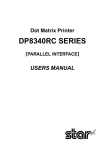
![User`s Manual DP8340II R SERIES [Serial]](http://vs1.manualzilla.com/store/data/005993516_1-f706d7540b19c5fecea062c6335f03cc-150x150.png)


![User's Manual DP8340II SERIES [Parallel]](http://vs1.manualzilla.com/store/data/006876520_1-e14f27ca3e82bd4fbe61e6010073af1e-150x150.png)
